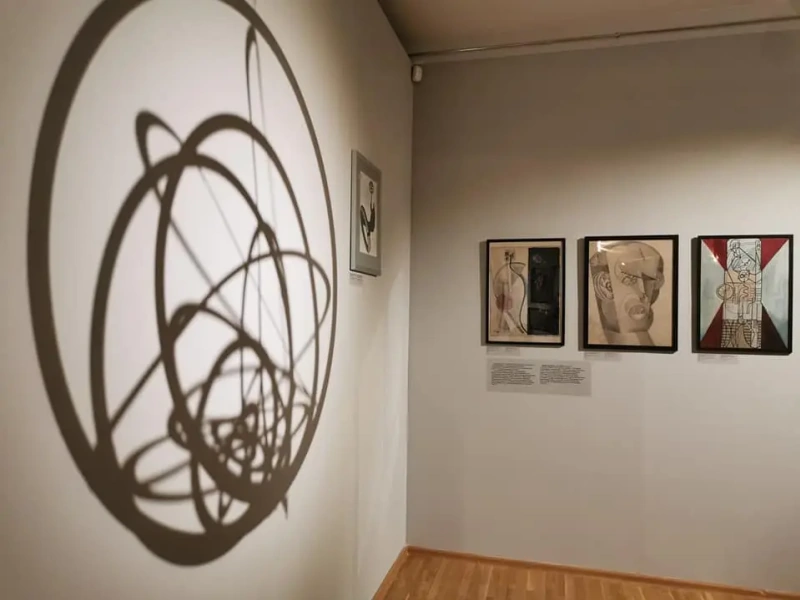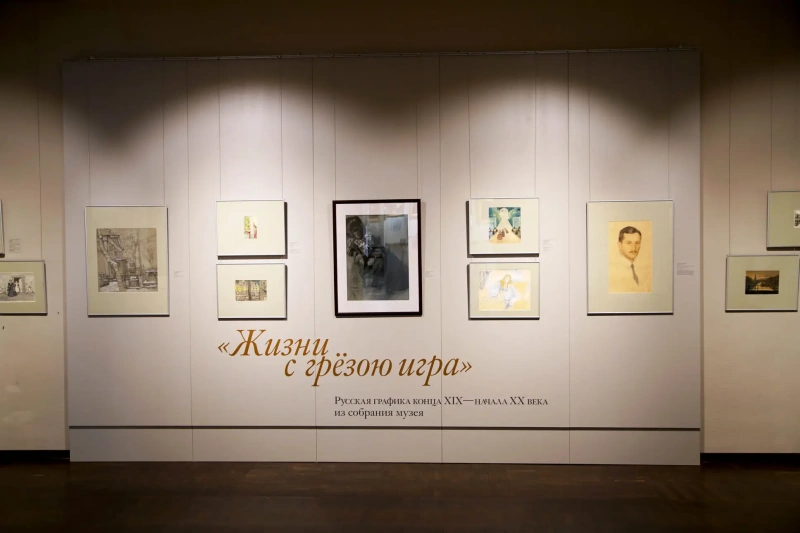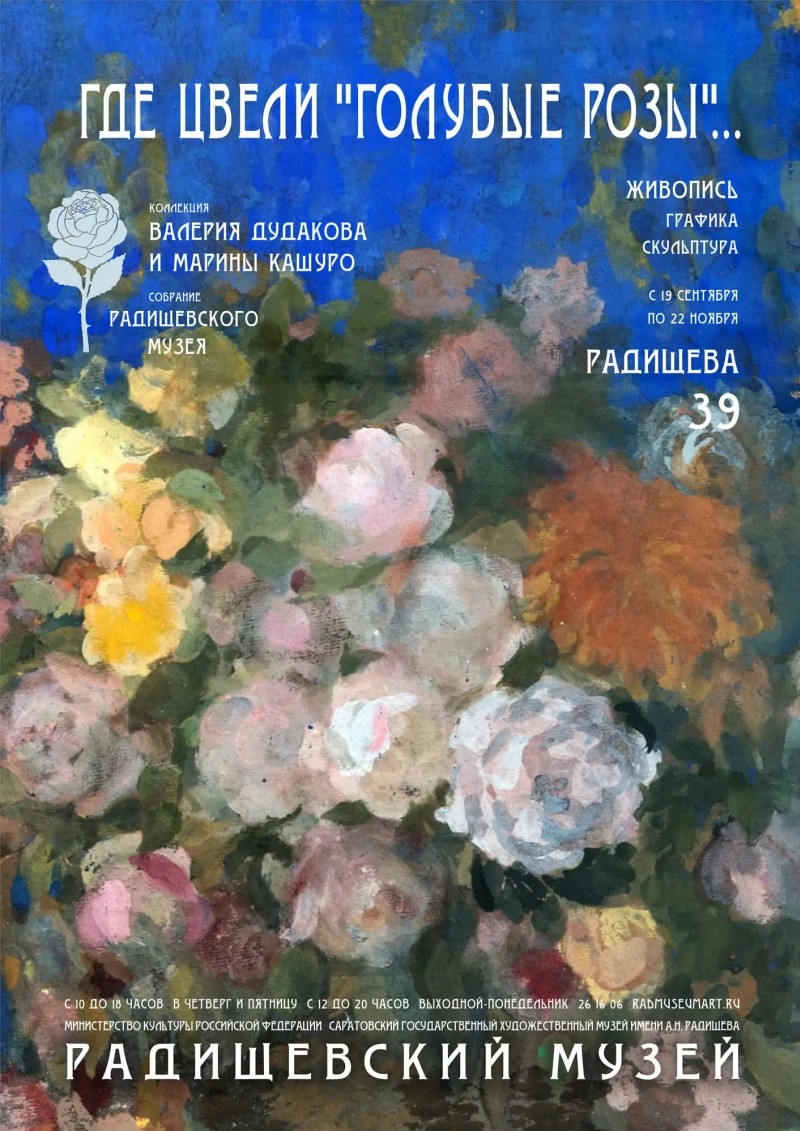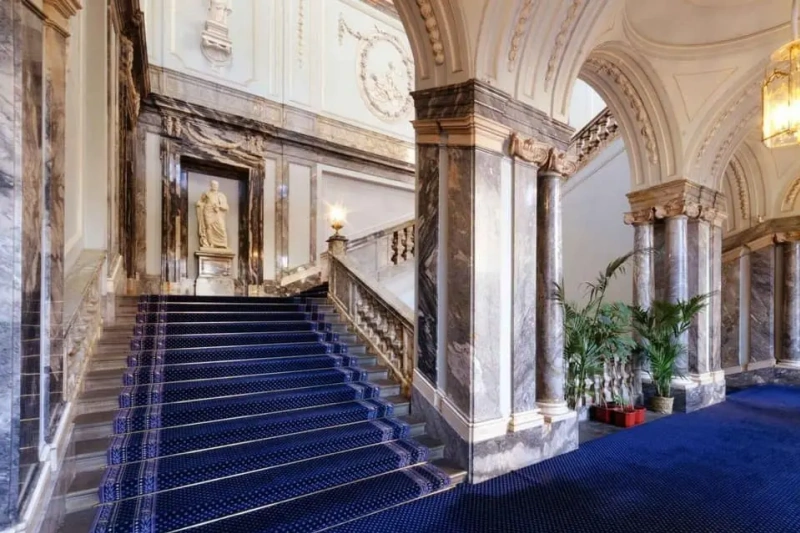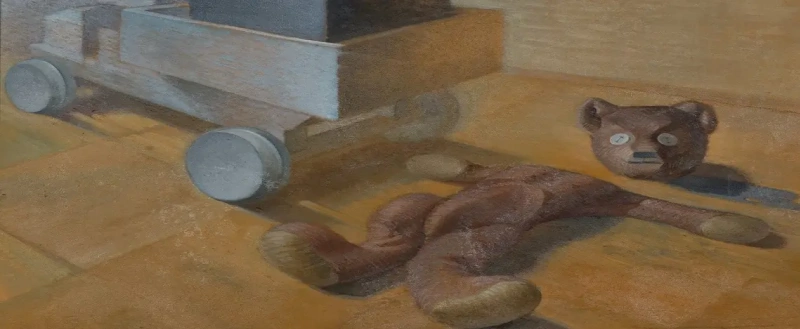log in
Enter site
Login to use Arthive functionality to the maximum
Kuzma Sergeevich Petrov-Vodkin (October 24 (November 5), 1878, Khvalynsk - February 15, 1939, Leningrad) - Russian artist and writer, teacher and graphic artist. In the variety of European and Russian artistic movements of the beginning of the 20th century, Petrov-Vodkin found similar ideas, but always adhered to his own painting style. He is a lone artist, cosmopolitan and eternal vagabond who searched for universal human meanings in every nation, in its traditions and directions of development.
Features of the artist Kuzma Petrov-Vodkin: the artistic language of Petrov-Vodkin was formed at the intersection of traditions and avant-garde ideas. The ancient Russian icon, the Italian Renaissance, Cubism, Fauvism, Post-Impressionism - all these influences intertwined in search of an artist and became a mainstay in his own sincere, direct study of the world, people. Never refusing figurativeness, Petrov-Vodkin boldly experimented with pure color and flat forms, with mystical, cosmic perspectives and symbolic subjects. The artist gained his own style not in schools and museums (although he studied painting skill for a very long time and persistently), but in traveling, studying faces and figures, gestures and actions.
Famous paintings of Kuzma Petrov-Vodkin: "Bathing a red horse", "Herring", "Anxiety", "Sleep", "Boys playing", "1918 in Petrograd (Petrograd Madonna)".
Kuzma Petrov-Vodkin is a man of the earth. Stepping firmly and growing into the ground with his steps, he felt a connection with her. In the African deserts and in the viscous ash of Vesuvius, in the Breton forests and dusty roads of Samarkand, he pawed invisible, winding lines that sew together the universal truth, once lost, divided into national traits and traditions.
Kuzma Petrov-Vodkin - the man of the cosmos. The insights, forebodings, foreseen visions were for him the same real, intertwined in the life line of events, like studying at a school or a revolution in the country. Under the Sun or under the Moon - he felt at home anywhere, wherever he went. Everywhere it was the same Sun and the same Moon, and the same planet with a rounded, promising cosmic infinity horizon.
He considered the restoration of ties, earthly and heavenly, inter-ethnic and social, the connections of form and color to be the main work of the artist.
Beginning of life
Kuzma was a long-awaited child. For him, they crafted a cradle and painted it with blue patterns. Grandmothers, parents, uncles, and sometimes neighbors fled to this cradle, as soon as he spoke. His father, Sergei Vodkin, was a shoemaker, and his mother worked as a nanny, and later as a servant in the house of a local merchant.
Far from both capitals, Khvalynsk, where Petrov-Vodkin was born, was an ordinary provincial town. Here former serfs, once lost in the cards, lived, Old Believers, who fled away from Moscow. Here, one man could kill another in a fistfight, and then from repentance he would wear his family’s whole life presents. Here the Old Believers and the Orthodox served one rich man - and before lunch they prayed in turn. Some are for themselves, others are for themselves. Here they often looked at the sky and told the children about the device of the Universe the truth and fiction, were afraid of eclipse, beat their wives, slept in the summer under the open sky, read books until they scattered and rubbed into holes, floated in the Volga and got together to watch on stargazing. Here they knew only about two types of artists: Old Believers' icon painters and painters, signboards. Peredvizhniki, of course, did not reach here. And, of course, there were no museums for a thousand kilometers around.
Therefore, Kuzma, when he passed the exams at the end of the 4th grade of the city school, dreamed of pulling out a ticket “About color”, not about electricity or sound, but he knew his vocation very vaguely and where to send it, did not really understand. Discussing further studies with the boys, he blurted out, so as not to seem confused: “I am going to enter the railway school in Samara”.
Petrov-Vodkin would be prevented from joining the railroad workers, apparently, even then the determined literary gift. On the exam in the history of Russia, he would not have enough of the issued paper, nor the time to present such a voluminous material. He will fail.
Learning
A few years later, when Petrov-Vodkin would give drawing lessons to two high-school students in Moscow and become close with the whole family, he suddenly realizes that he himself did not have a youth. He immediately became an adult from a child I watched with excitement over my older sister of my students, her circle of friends, poems, dances, sighs, novels. Kuzma did not know this. Having failed the railway future, he began to take painting lessons in the workshop of the Samara artist Burov and grab hold of any work. He was interrupted by modest earnings, and in his free time he made sketches of faces and landscapes from nature.
After the death of the old Burov, 17-year-old Kuzma Petrov-Vodkin assembled an artel of artists, signage workers, tried to help local icon painters, but not a single idea worked. There - the merchants did not want to put up with useless embellishment, here - there was not enough artistic skill for Petrov-Vodkin himself.
However, his skills and obvious artistic gift was enough to get an unexpected scholarship for the coming years. The famous architect who visited Khvalynsk was shown the works of Kuzma, he praised, and the local merchant, of the rich, suddenly decided to support the young artist and assigned him a content that enabled him to go to study in St. Petersburg.
Drawing teacher at the Central School of Technical Drawing Baron Stieglitz Kuzma brought to despair. “You are capable, but you are not neat!” - the teacher shook his head. Here it was necessary to learn to mint, crush the skin, make a drawing of the cabinet so that the master understood how to make it. And Petrov-Vodkin showed obvious painting skills, but not technical ones. The failed furniture maker will go to the Moscow School of Painting at her best time. Academic frameworks are cracking here, the system of training is being redrawn, Serov has just started to teach, and Levitan and Korovin will soon arrive, and Larionov and Saryan are among the students.
For Petrov-Vodkin, this is not only a time of rapid artistic growth, but also a time of personal growth. Hastily and on top of the ideas of science and the world in the elementary school, he now eagerly supplements the courses of chemistry and physics, reads avidly about the history of culture and the structure of the Earth. His intellectual hunger, interrupted until now by peasant legends and vague guesses, is finally satisfied with theories, disputes, scientific research and his own first writers' successes.
Travels
Of course, sooner or later, Petrov-Vodkin would have the idea to go to Paris. But there he will not get right away. The first road adventure of the artist becomes a bike ride to Munich. In the middle of the way, having given the bike to a fellow traveler, he gets to his destination, the school of the artist Anton Aschbe, a hungry, frightened, desperate vagabond, who also managed to break the German laws of displacement. The next time, he will be raptured by galleries and streets of Italian cities for 4 months, climbing to the volcano, falling into robbers, falling in love and learning from the old masters.
By the age of 28, Petrov-Vodkin had already graduated from the Moscow School, gained experience and skillfully mastered the technique of drawing and painting techniques, his play was in the theater, and the stories were printed. But the last creative insight, his own manner was still not enough - and this was the best time to gather in Paris.
In the city wherePicasso just writing"Avignon girls" and where just arrived ModiglianiPetrov-Vodkin lives far away from the bohemian neighborhoods, visits the private Kolarossi Academy and walks through avant-garde exhibitions and art dealers' galleries, makes hundreds of drawings and writes cityscapes. He will return to Russia with a cycle of African paintings, with his wife Maria Josefina Jovanovic, with disappointment in impressionism, with love forCezanne and and, finally, with the established idea of their own artistic tasks.
Return
The years spent by the artist in intense search and honest apprenticeship, prepared almost instant success. Upon his return to Russia, Petrov-Vodkin immediately occupies a special position: between stubborn traditionalists and frantic innovators. He who watchedLeonardo and Matisse,Giotto and Picasso, becomes that unique artist who is given unity: the mighty monumentality of the classics plus the energetic emotionality of the avant-garde.
Petrov-Vodkin becomes the hope, discovery, icon and banner of the Petersburg aesthetic art magazine Apollo and its founder Sergei Makovsky. Immediately - a personal exhibition and enthusiastic articles, fame in both capitals and recognition of young fellow artists, public performances and lectures.
From 1909 to 1917, Petrov-Vodkin is in demand and famous. And unlike many artists, whose life changes dramatically after the revolution, remains in demand after the coup. He takes global changes in the country as an opportunity for renewal: he heads the painting department of the Higher Art School, takes up reforms as part of the Special Council on Arts, believes in the future, travels to Turkestan with a scientific expedition, spends the summer in Khvalynsk, returns to the capital for the winter. All this time, from long Samarkand expeditions, from lectures and classes, Mar. Yovanovitch is waiting for him at home. Maria, who changed her last name and lifestyle, left Paris, abandoned music lessons, acquired the Russian manners with the patronymic, and dreams only of one thing - to give birth to Kuzma baby which he has been waiting for obsession for many years and speaks, conjures fate with the most effective, proven method - painting. One after another he writes mothers with babies in their arms.
Daughter
Petrov-Vodkin wrote two autobiographical books, after which the offended Maxim Gorky (his name was not mentioned in them even casually) named the author Munchausen. Very much the passionate clashes of the artist with the earthly elements, hungry vagrancy-pilgrimage through half-planets, and prophetic forebodings were romantically read. But there were legends about the prophetic visions of the artist, so one can believe in one of the most momentous ones.
Petrov-Vodkin saw Maria, the mistress’s daughter, with whom he rented accommodation in Paris, not very often. Communicated very little. And suddenly, directly and persistently made her an offer. To the surprised question of the girl, why should she give an answer to such a frivolous proposal, he replied that he had a vision. He saw her next to him in Russia. And with them was their daughter.
Daughter Elena will be born only 15 years later. Sick and poorly tolerated pregnancy Mara will sign a paper stating that in case of a critical choice she insistently demands to save the life of the child, and not her own. He will spend three months after giving birth in the hospital, will not get out of bed for a long time - and all this time Petrov-Vodkin is caring for the child, feeding, bathing and giving up all the strong parental love and energy that is waiting for him. He writes baby Lena endlessly, quits teaching to take her to the village. She becomes the meaning of his life. She and ... another child.
Lonely, who devoted her life to her husband Mara invites her friend to live with her while Kuzma Sergeevich rides through Turkestan. And the cheerful, sincere, easy Natalie soon becomes a member of the family. Her daughter will be born 5 months after Lena. And the father of the girl will also be Petrov-Vodkin. A carefree, bright, decadent, painful triple alliance will soon of course become impossible - and Natalie and her daughter will leave.
Mara will stay close to her husband in those painful years when he will be sick and weak, when his art will become suspicious and persecuted. Dying of tuberculosis, Petrov-Vodkin fills the apartment with paintings that are less likely to be safely displayed. He will die at a terrible time, in the years of repression, searches and night arrests, which once premonition and wrote. His wife and daughter will gradually sell for a pittance paintings in private collections in order not to die of starvation. And only many decades later these collections will move to museums and they will start talking about Petrov-Vodkin as a unique artist who did not belong to any artistic direction, let through the power of the earth and the power of space, found the point of unity of tradition and innovation and followed the obvious, sincere goal. : “To be a collector of man on Earth, to unite together all the beauty of world outlook, divided by nations and countries”.
Author: Anna Sidelnikova
Read more
Features of the artist Kuzma Petrov-Vodkin: the artistic language of Petrov-Vodkin was formed at the intersection of traditions and avant-garde ideas. The ancient Russian icon, the Italian Renaissance, Cubism, Fauvism, Post-Impressionism - all these influences intertwined in search of an artist and became a mainstay in his own sincere, direct study of the world, people. Never refusing figurativeness, Petrov-Vodkin boldly experimented with pure color and flat forms, with mystical, cosmic perspectives and symbolic subjects. The artist gained his own style not in schools and museums (although he studied painting skill for a very long time and persistently), but in traveling, studying faces and figures, gestures and actions.
Famous paintings of Kuzma Petrov-Vodkin: "Bathing a red horse", "Herring", "Anxiety", "Sleep", "Boys playing", "1918 in Petrograd (Petrograd Madonna)".
Kuzma Petrov-Vodkin is a man of the earth. Stepping firmly and growing into the ground with his steps, he felt a connection with her. In the African deserts and in the viscous ash of Vesuvius, in the Breton forests and dusty roads of Samarkand, he pawed invisible, winding lines that sew together the universal truth, once lost, divided into national traits and traditions.
Kuzma Petrov-Vodkin - the man of the cosmos. The insights, forebodings, foreseen visions were for him the same real, intertwined in the life line of events, like studying at a school or a revolution in the country. Under the Sun or under the Moon - he felt at home anywhere, wherever he went. Everywhere it was the same Sun and the same Moon, and the same planet with a rounded, promising cosmic infinity horizon.
He considered the restoration of ties, earthly and heavenly, inter-ethnic and social, the connections of form and color to be the main work of the artist.
Beginning of life
Kuzma was a long-awaited child. For him, they crafted a cradle and painted it with blue patterns. Grandmothers, parents, uncles, and sometimes neighbors fled to this cradle, as soon as he spoke. His father, Sergei Vodkin, was a shoemaker, and his mother worked as a nanny, and later as a servant in the house of a local merchant.
Far from both capitals, Khvalynsk, where Petrov-Vodkin was born, was an ordinary provincial town. Here former serfs, once lost in the cards, lived, Old Believers, who fled away from Moscow. Here, one man could kill another in a fistfight, and then from repentance he would wear his family’s whole life presents. Here the Old Believers and the Orthodox served one rich man - and before lunch they prayed in turn. Some are for themselves, others are for themselves. Here they often looked at the sky and told the children about the device of the Universe the truth and fiction, were afraid of eclipse, beat their wives, slept in the summer under the open sky, read books until they scattered and rubbed into holes, floated in the Volga and got together to watch on stargazing. Here they knew only about two types of artists: Old Believers' icon painters and painters, signboards. Peredvizhniki, of course, did not reach here. And, of course, there were no museums for a thousand kilometers around.
Therefore, Kuzma, when he passed the exams at the end of the 4th grade of the city school, dreamed of pulling out a ticket “About color”, not about electricity or sound, but he knew his vocation very vaguely and where to send it, did not really understand. Discussing further studies with the boys, he blurted out, so as not to seem confused: “I am going to enter the railway school in Samara”.
Petrov-Vodkin would be prevented from joining the railroad workers, apparently, even then the determined literary gift. On the exam in the history of Russia, he would not have enough of the issued paper, nor the time to present such a voluminous material. He will fail.
Learning
A few years later, when Petrov-Vodkin would give drawing lessons to two high-school students in Moscow and become close with the whole family, he suddenly realizes that he himself did not have a youth. He immediately became an adult from a child I watched with excitement over my older sister of my students, her circle of friends, poems, dances, sighs, novels. Kuzma did not know this. Having failed the railway future, he began to take painting lessons in the workshop of the Samara artist Burov and grab hold of any work. He was interrupted by modest earnings, and in his free time he made sketches of faces and landscapes from nature.
After the death of the old Burov, 17-year-old Kuzma Petrov-Vodkin assembled an artel of artists, signage workers, tried to help local icon painters, but not a single idea worked. There - the merchants did not want to put up with useless embellishment, here - there was not enough artistic skill for Petrov-Vodkin himself.
However, his skills and obvious artistic gift was enough to get an unexpected scholarship for the coming years. The famous architect who visited Khvalynsk was shown the works of Kuzma, he praised, and the local merchant, of the rich, suddenly decided to support the young artist and assigned him a content that enabled him to go to study in St. Petersburg.
Drawing teacher at the Central School of Technical Drawing Baron Stieglitz Kuzma brought to despair. “You are capable, but you are not neat!” - the teacher shook his head. Here it was necessary to learn to mint, crush the skin, make a drawing of the cabinet so that the master understood how to make it. And Petrov-Vodkin showed obvious painting skills, but not technical ones. The failed furniture maker will go to the Moscow School of Painting at her best time. Academic frameworks are cracking here, the system of training is being redrawn, Serov has just started to teach, and Levitan and Korovin will soon arrive, and Larionov and Saryan are among the students.
For Petrov-Vodkin, this is not only a time of rapid artistic growth, but also a time of personal growth. Hastily and on top of the ideas of science and the world in the elementary school, he now eagerly supplements the courses of chemistry and physics, reads avidly about the history of culture and the structure of the Earth. His intellectual hunger, interrupted until now by peasant legends and vague guesses, is finally satisfied with theories, disputes, scientific research and his own first writers' successes.
Travels
Of course, sooner or later, Petrov-Vodkin would have the idea to go to Paris. But there he will not get right away. The first road adventure of the artist becomes a bike ride to Munich. In the middle of the way, having given the bike to a fellow traveler, he gets to his destination, the school of the artist Anton Aschbe, a hungry, frightened, desperate vagabond, who also managed to break the German laws of displacement. The next time, he will be raptured by galleries and streets of Italian cities for 4 months, climbing to the volcano, falling into robbers, falling in love and learning from the old masters.
By the age of 28, Petrov-Vodkin had already graduated from the Moscow School, gained experience and skillfully mastered the technique of drawing and painting techniques, his play was in the theater, and the stories were printed. But the last creative insight, his own manner was still not enough - and this was the best time to gather in Paris.
In the city wherePicasso just writing"Avignon girls" and where just arrived ModiglianiPetrov-Vodkin lives far away from the bohemian neighborhoods, visits the private Kolarossi Academy and walks through avant-garde exhibitions and art dealers' galleries, makes hundreds of drawings and writes cityscapes. He will return to Russia with a cycle of African paintings, with his wife Maria Josefina Jovanovic, with disappointment in impressionism, with love forCezanne and and, finally, with the established idea of their own artistic tasks.
Return
The years spent by the artist in intense search and honest apprenticeship, prepared almost instant success. Upon his return to Russia, Petrov-Vodkin immediately occupies a special position: between stubborn traditionalists and frantic innovators. He who watchedLeonardo and Matisse,Giotto and Picasso, becomes that unique artist who is given unity: the mighty monumentality of the classics plus the energetic emotionality of the avant-garde.
Petrov-Vodkin becomes the hope, discovery, icon and banner of the Petersburg aesthetic art magazine Apollo and its founder Sergei Makovsky. Immediately - a personal exhibition and enthusiastic articles, fame in both capitals and recognition of young fellow artists, public performances and lectures.
From 1909 to 1917, Petrov-Vodkin is in demand and famous. And unlike many artists, whose life changes dramatically after the revolution, remains in demand after the coup. He takes global changes in the country as an opportunity for renewal: he heads the painting department of the Higher Art School, takes up reforms as part of the Special Council on Arts, believes in the future, travels to Turkestan with a scientific expedition, spends the summer in Khvalynsk, returns to the capital for the winter. All this time, from long Samarkand expeditions, from lectures and classes, Mar. Yovanovitch is waiting for him at home. Maria, who changed her last name and lifestyle, left Paris, abandoned music lessons, acquired the Russian manners with the patronymic, and dreams only of one thing - to give birth to Kuzma baby which he has been waiting for obsession for many years and speaks, conjures fate with the most effective, proven method - painting. One after another he writes mothers with babies in their arms.
Daughter
Petrov-Vodkin wrote two autobiographical books, after which the offended Maxim Gorky (his name was not mentioned in them even casually) named the author Munchausen. Very much the passionate clashes of the artist with the earthly elements, hungry vagrancy-pilgrimage through half-planets, and prophetic forebodings were romantically read. But there were legends about the prophetic visions of the artist, so one can believe in one of the most momentous ones.
Petrov-Vodkin saw Maria, the mistress’s daughter, with whom he rented accommodation in Paris, not very often. Communicated very little. And suddenly, directly and persistently made her an offer. To the surprised question of the girl, why should she give an answer to such a frivolous proposal, he replied that he had a vision. He saw her next to him in Russia. And with them was their daughter.
Daughter Elena will be born only 15 years later. Sick and poorly tolerated pregnancy Mara will sign a paper stating that in case of a critical choice she insistently demands to save the life of the child, and not her own. He will spend three months after giving birth in the hospital, will not get out of bed for a long time - and all this time Petrov-Vodkin is caring for the child, feeding, bathing and giving up all the strong parental love and energy that is waiting for him. He writes baby Lena endlessly, quits teaching to take her to the village. She becomes the meaning of his life. She and ... another child.
Lonely, who devoted her life to her husband Mara invites her friend to live with her while Kuzma Sergeevich rides through Turkestan. And the cheerful, sincere, easy Natalie soon becomes a member of the family. Her daughter will be born 5 months after Lena. And the father of the girl will also be Petrov-Vodkin. A carefree, bright, decadent, painful triple alliance will soon of course become impossible - and Natalie and her daughter will leave.
Mara will stay close to her husband in those painful years when he will be sick and weak, when his art will become suspicious and persecuted. Dying of tuberculosis, Petrov-Vodkin fills the apartment with paintings that are less likely to be safely displayed. He will die at a terrible time, in the years of repression, searches and night arrests, which once premonition and wrote. His wife and daughter will gradually sell for a pittance paintings in private collections in order not to die of starvation. And only many decades later these collections will move to museums and they will start talking about Petrov-Vodkin as a unique artist who did not belong to any artistic direction, let through the power of the earth and the power of space, found the point of unity of tradition and innovation and followed the obvious, sincere goal. : “To be a collector of man on Earth, to unite together all the beauty of world outlook, divided by nations and countries”.
Author: Anna Sidelnikova
-
Artworks liked by338 users
- Artworks in 4 collections and 406 selections
Publicaciones
Exposiciones
Todas las exposiciones del pintor
Samarkand
1926, 57×76 cm

Family commander
1936, 75.5×61 cm

Portrait of the daughter with globe
1936, 128×88 cm

Mother and child
1927, 52×38 cm

The boy's head in the background a rural landscape
1927, 37×31 cm

Working
1926, 97×106 cm

Ally. Sketch for the cover of the magazine "Red field"
1926, 25×23 cm

Old Dieppe
1925, 24×33 cm
Bandeja
The ABC of a Masterpieceexhibition finished

18 December 2021 − 19 June 2022 Istra, Novo-Ierusalimskaya Embankment, 1
Russian Avant-Garde: Mechanics, Construction, Lifeexhibition finished

11 November 2021 − 30 May 2022 Saint Petersburg, Russia, Peter and Paul Fortress, Alexander Park, 7




